
Patchwork and Quilting: Make a Table Runner
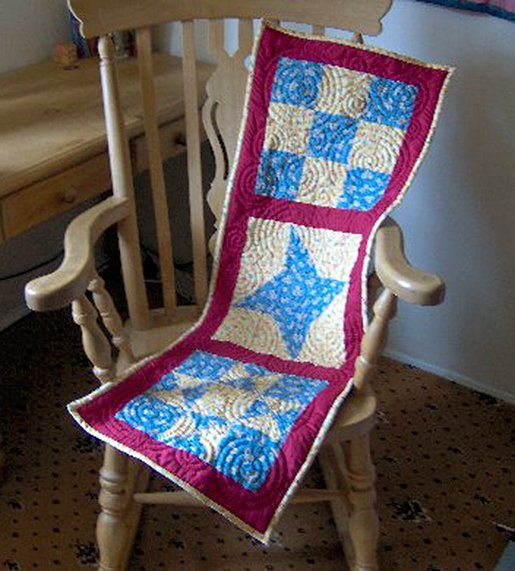
I have used three patchwork blocks to make a table runner, but the instructions given can easily be adapted to make placemats using just one block or add more blocks and make a quilt.
You will need:
Fabric for backing, sashing (joining strips) and borders
Fabric for binding (I have used the same fabric I used for the patchwork blocks)
Wadding (batting - available in a variety of thicknesses depending on the desired result required)
Sewing equipment (pins, needles, ruler/tape measure, scissors, threads for tacking, sewing and quilting, ¼ inch rule, fabric pencil)
Paper (I use printer paper), pencil, scissors, sticky tape
Quilting hoop/frame (optional)
Iron
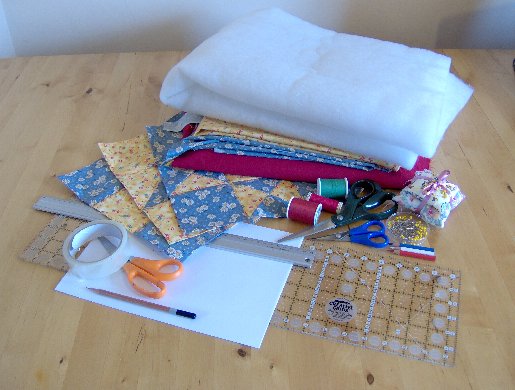
What to do
Before you begin, all new fabrics must be washed and ironed.
1. Decide how you want to arrange your patchwork blocks. We will now start making the sashing (joining strips), using the centre patchwork block measure exactly the length of the left hand side and decide how wide you want the strips to be, (mine are 2 inches/5cm wide) and make a paper template, joining sheets of paper together with sticky tape if necessary. (It's a good idea to write on the paper which strip it is so you know exactly where it goes when you come to sew them together)

2. Pin the paper template to the back of the sashing fabric and adding a ¼ inch seam allowance cut out the fabric strip (just like when you were cutting out the patches to make a block). Turn the seams over the paper, making sure the corners are neat and tack in place. Remove the pins.
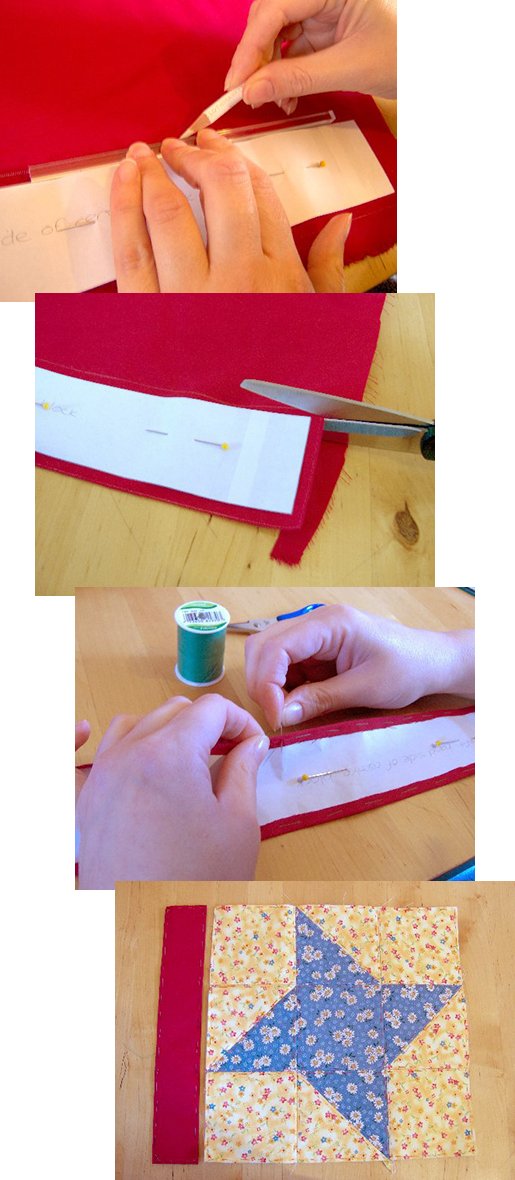
3. Make a sashing strip for the right hand side of the centre patchwork block in the same way.
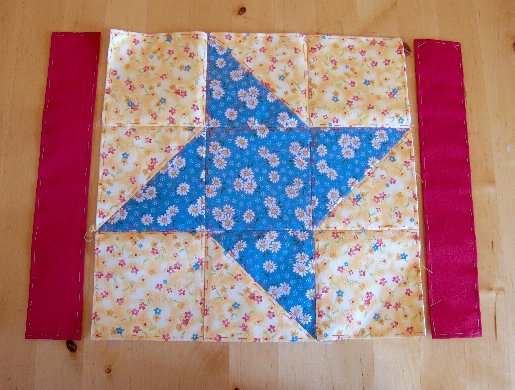
4. With right sides facing, pin the left hand side sashing strip to the left hand side of the centre patchwork block. Sew together with small oversewing stitches just like you did when joining the patches for the blocks together. Remove the pins.
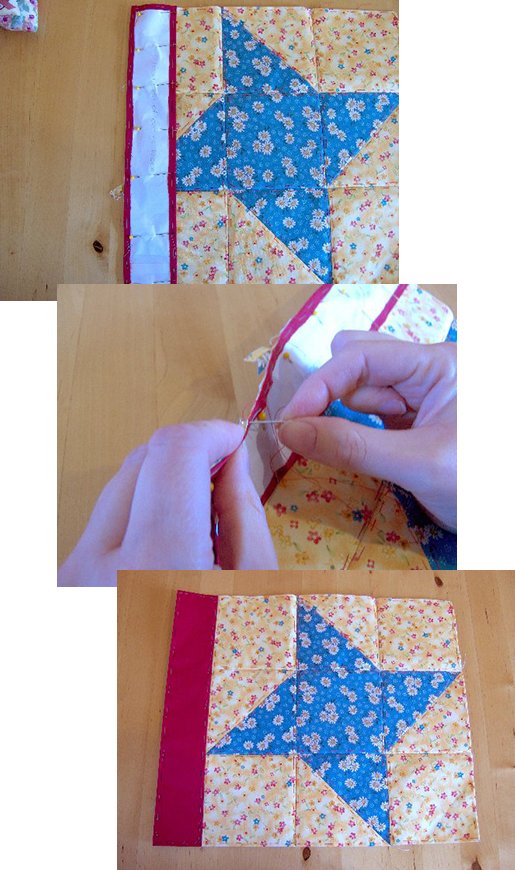
5. Pin and then sew the right hand strip to the patchwork block in the same way.
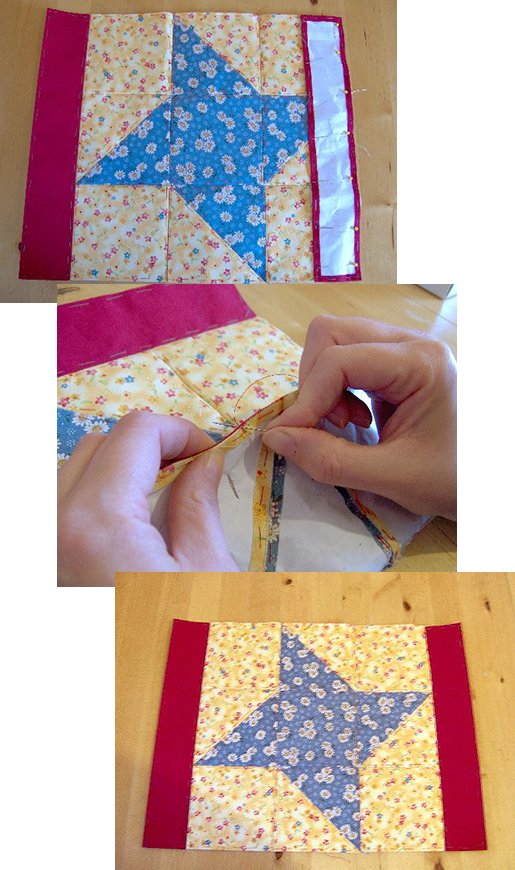
6. With right sides facing, pin the left hand patchwork block to the sashing strip on the left side of the centre patchwork block and sew together.
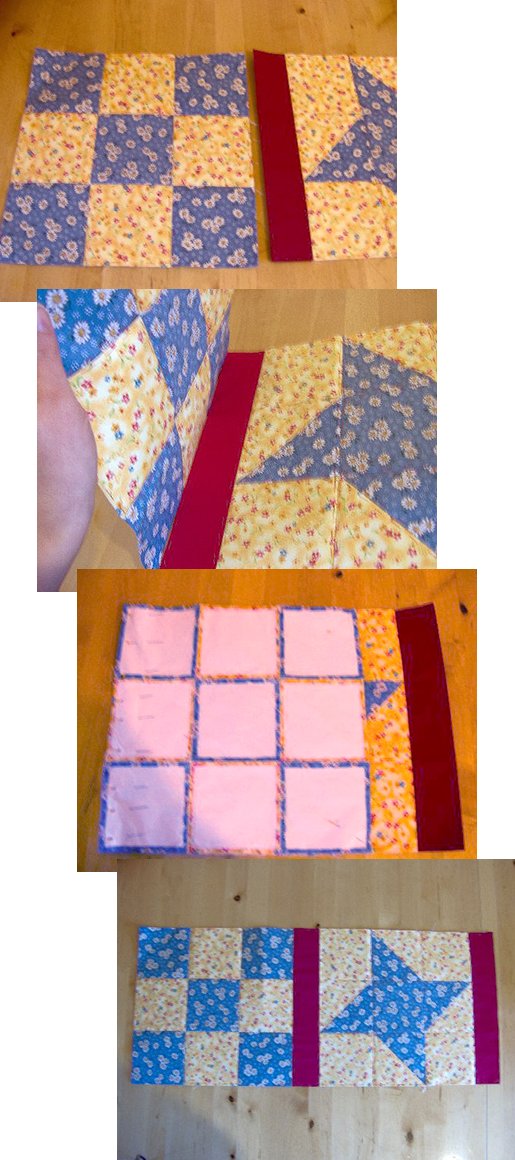
7. With right sides facing, pin the right hand patchwork block to the sashing strip on the right side of the centre patchwork block and sew together. You should now have three patchwork blocks joined together with two sashing strips.
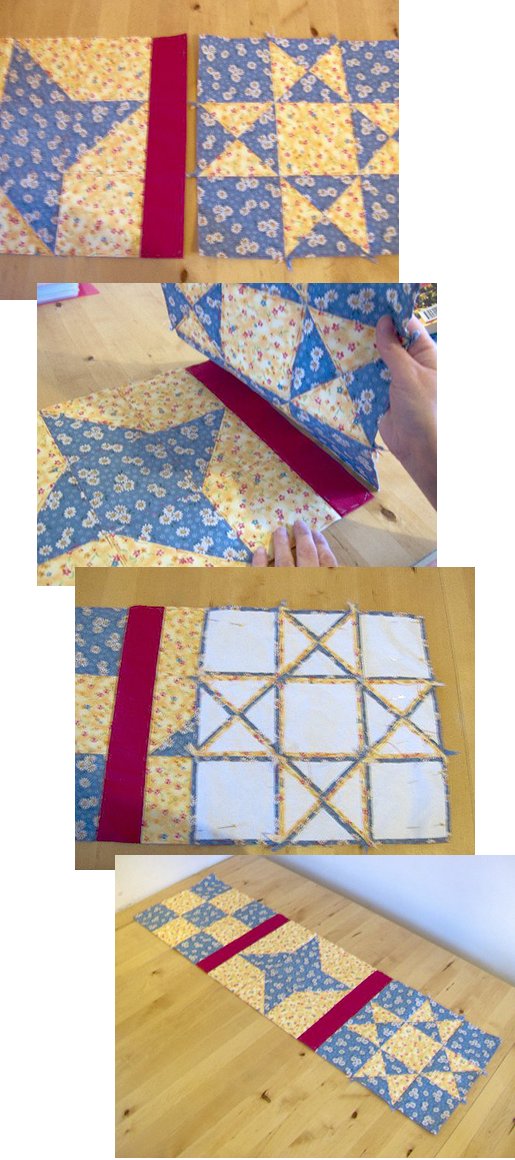
8. Make two more strips, one for each end, these are border strips, and with right sides facing, sew these to the two outer patchwork blocks.
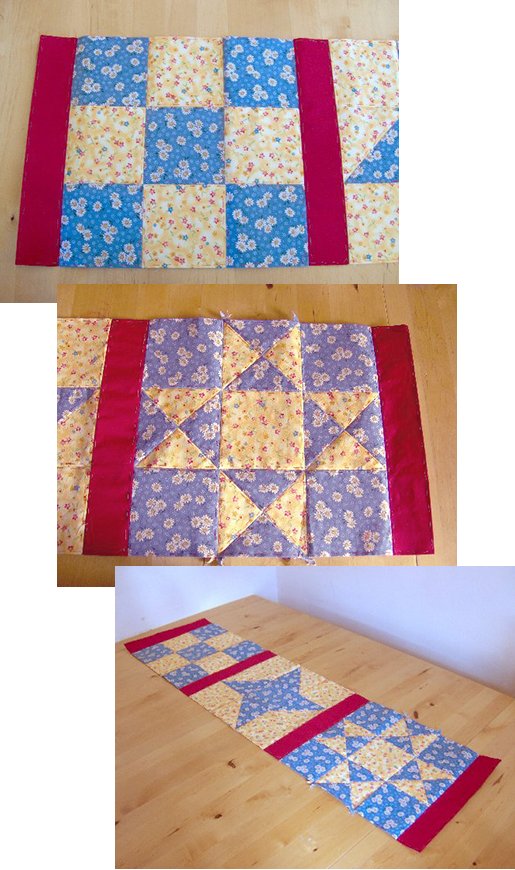
9. To make the last two border strips, measure the total length of the three patchwork blocks, two sashing and two border strips and make two long paper templates (I needed to join four pieces of paper together to make the templates). Continue to make them into two long fabric strips just as you did when making the two shorter border strips, one to go across the top and one for the bottom, pin in place with right sides facing and sew as before thus completing the table runner top.

10. Carefully remove the tacking stitches and papers. When you remove the papers from the border you must then re-tack the outside edge, this will keep the edge neat and ready for sewing.

11. Choose a quilting pattern.
(This can simply be highlighting the shapes of the patches and boarders in the quilt top (no sewing line needed to be drawn onto fabric, just quilt 2-3mm in from each patch edge), or choosing a totally different pattern shape such as flowers, feathers, stripes, circles etc. Ready made shapes and stencils can be bought or you can design and make your own out of template plastic or card. When you have decided, tape the stencil onto the fabric top and mark your quilting design with a fabric pen/pencil that can be easily removed when quilting is complete (please read manufacturers instructions)).
I have chosen a swirl pattern in three sizes so I will need to make a stencil and draw the pattern onto the fabric.
Making a Stencil
You will need:
Template plastic or card
Permanent marker
Craft knife
Cutting mat
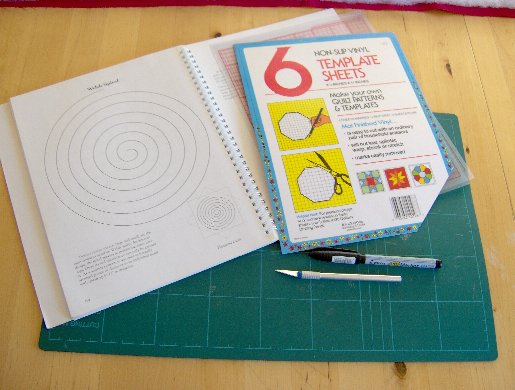
What to do
1. Lay a sheet of template plastic on top of your chosen design and trace the pattern onto the plastic using a permanent marker, alternatively photocopy the pattern and glue it to cardboard.
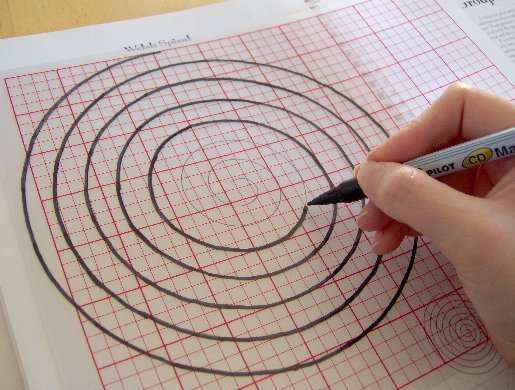
2. Using a craft knife cut out the design, cutting out a narrow space along the lines of the pattern about the width of the tip of your fabric pen/pencil. Remember to leave some small plastic/card bridges every 1-2 inches or the stencil will fall apart.
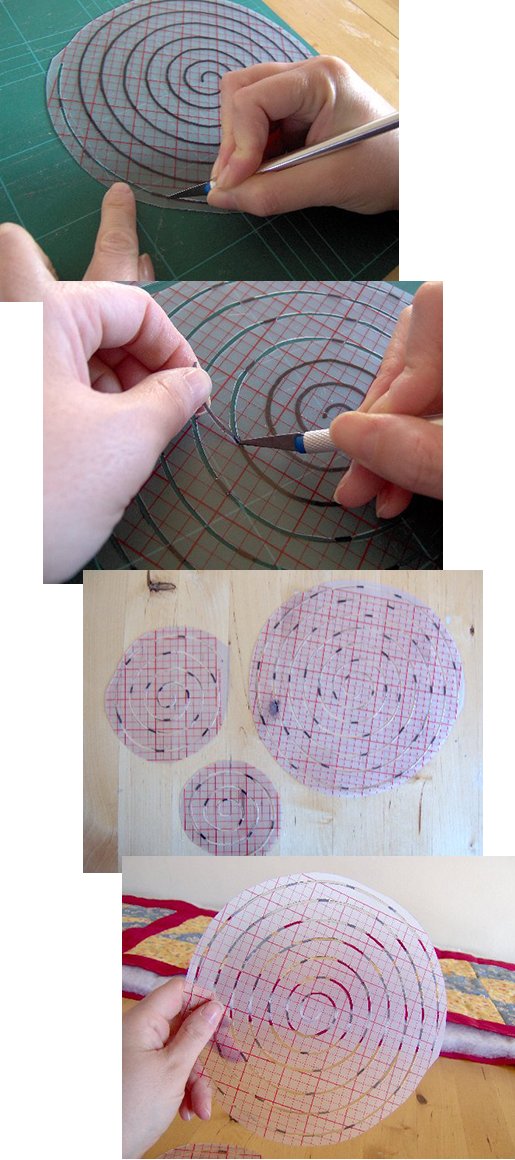
and back to the Table Runner...
12. Using a fabric pencil/marker that will fade or sponge-out draw your chosen quilting pattern onto the top of the quilt. Do not draw your design too near the edge as this will make it more tricky when sewing on the binding strips.
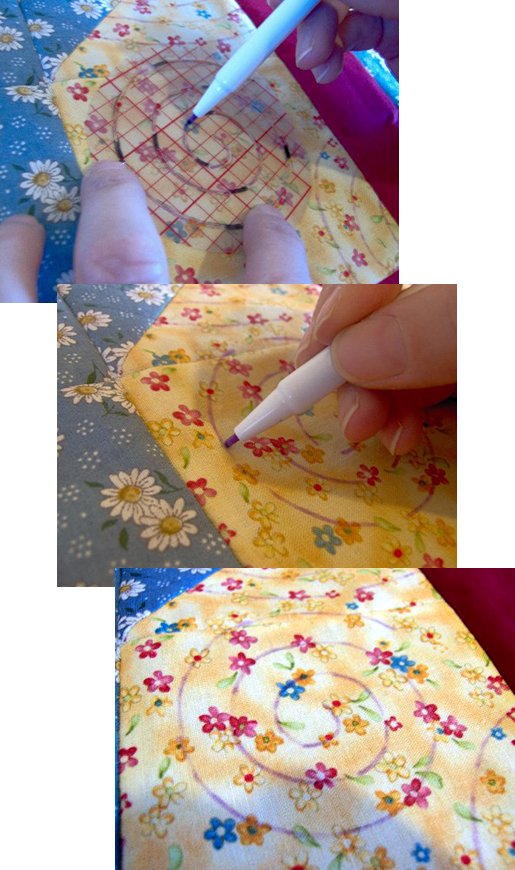
13. Lay the patchwork top onto your chosen wadding (batting) and cut a piece of wadding about 2 inches bigger than the patchwork all the way round.
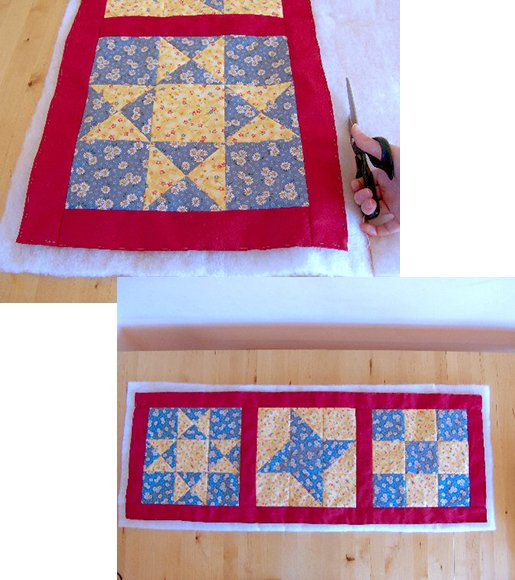
14. Lay the patchwork and wadding (batting) onto the backing fabric and cut out a piece just bigger than the wadding.
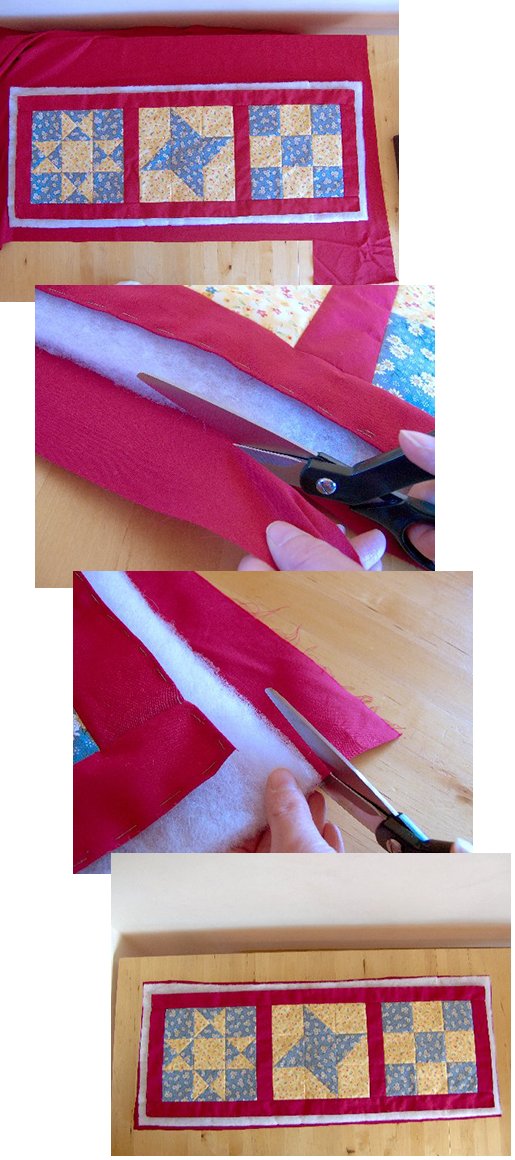
15. Starting in the centre and working out to the edges pin the three layers together making sure that they are flat and there are no creases on the front or back.
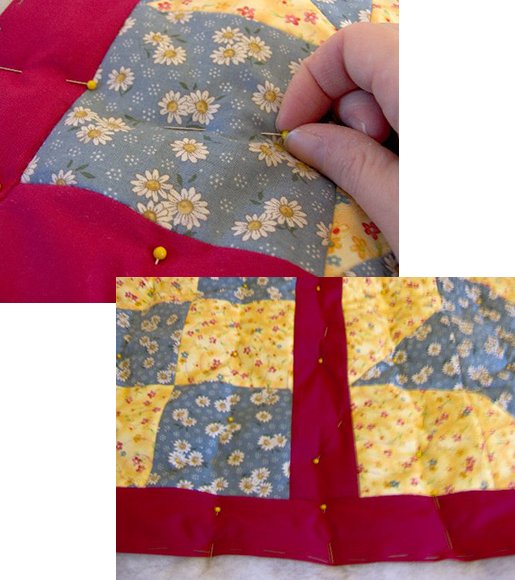
16. Starting in the centre and working out to the edges tack (baste) the three layers together, continuing to check that all layers are flat and not creased.
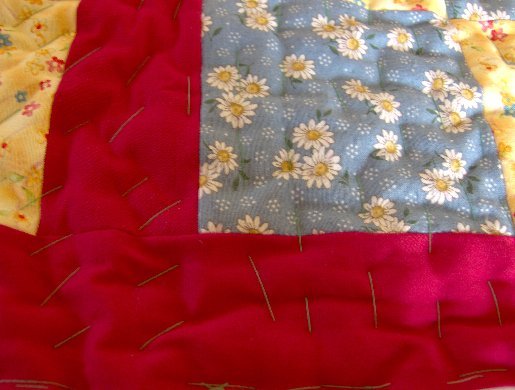
17. Now it's time to quilt! The quilting stitch is a simple straight running stitch that joins all three layers together (top, wadding & backing). You can use a thread that blends in with the fabric colour so that the stitches enhance the quilt but do not stand out or you can use a contrasting thread so that the stitches become more of a feature.
18. You may like to quilt using a hoop or frame to steady your work (optional). Start quilting in the centre of the fabric sandwich, knot the end of a length of quilting thread and pull the knotted end into the wadding (batting), follow your quilting pattern with a running stitch through all three layers and end the thread with a couple of backstitches or knotting the end and losing it in the wadding (batting). Aim for neat even stitches, if you want very small stitches then you will need to use a thin wadding (batting), if you use a thicker wadding (batting) for a deep padded look, the stitches may need to be longer but the important thing is to keep them even.

19. Once the quilting is completed, it is time to bind the quilt. Binding is a strip of fabric which wraps around the raw edge of the quilt, it protects the edges of the quilt and is available shop bought or made from fabric that has already been used in the quilt to complement the design and really adds a beautiful finishing touch.
There are a variety of ways to bind your quilt (bias or straight, single or double folded with rounded, butted or mitred corners). I will be using some of the same fabric I used for the patches, cut straight and single folded with the corners butted, this is one of the easier ways to bind a quilt, plus the butted corners will follow the quilts design.
20. The binding will be made out of four strips of fabric, one for each side of the quilt. First cut the fabric for the two shorter sides by measuring their length and adding 4 inches for safety (gives you 2 extra inches each end). Cut these two strips 2 inches wide.
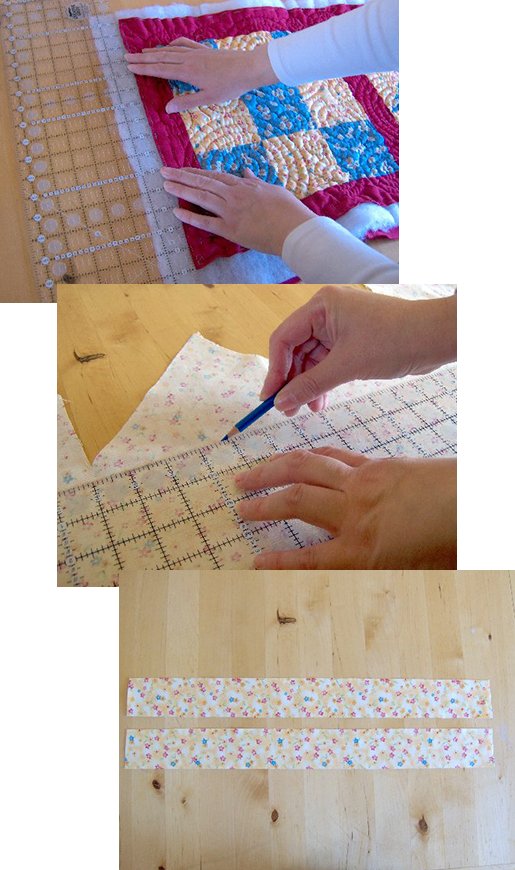
(If you need to join strips of binding together to make them the correct length, cut two lengths with the ends at a 45? angle, place them right sides together tacking in place using a ¼ inch seam allowance so that when opened out it will form a straight strip. Sew together following the tacking stitches using a small back-stitch and iron as a complete strip with the seams to one side)

Carefully and accurately fold the strips in half lengthways, with the wrong side of the fabric on the inside, using an iron to mark the centre fold. Open out the fabric and fold in the outer edges to meet the centre fold, iron in place. You may need to fold in half again and iron to crisp the three folds. It is now ready to be used as a binding strip.

21. Take one of the folded binding strips opening out the centre fold but keeping the outer folds folded, with right sides together pin or hold in place along the front edge of the quilt making sure that the binding is even and that the excess binding is at each end. Sew the binding strip to the quilt front in the same way as sewing patches together, using small oversewing stitches. (You may need to loosen some of the tacking stitches by carefully snipping the odd one in order to sew the two together easily.)
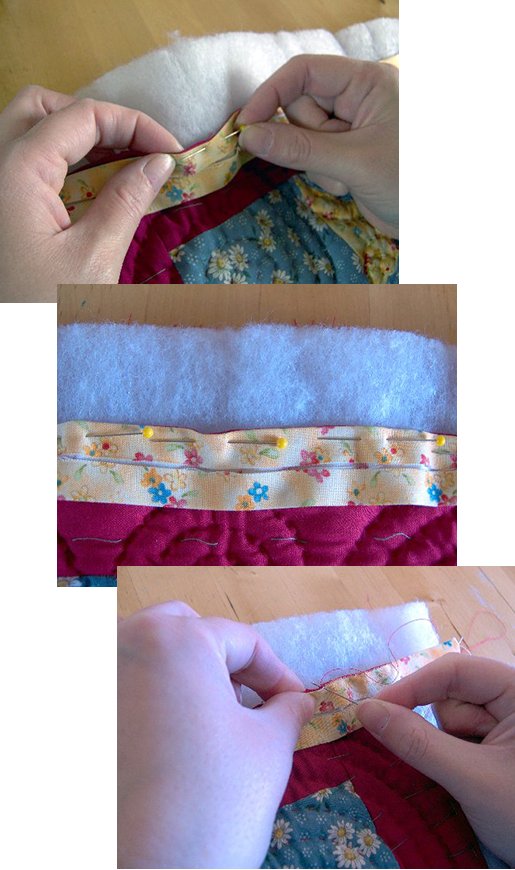
22. The binding should be of equal widths on both sides of the quilted edge and should appear 'full' rather than empty or overstuffed. The backing and wadding (batting) may therefore need a little trimming before the binding is sewn to the back of the quilt (be very careful not to cut off too much, as you need to make sure that when you sew the binding to the back, you are not sewing close to the edge of the backing fabric). The binding is folded over to the back of the quilt, pinned and/or tacked in place and sewn using a slip / blind stitch (the stitches should not be visible). Sew the second short binding piece to the opposite end of the quilt in exactly the same way.

23. Trim the surplus binding leaving 1cm to turn under when attaching the longer binding strips.
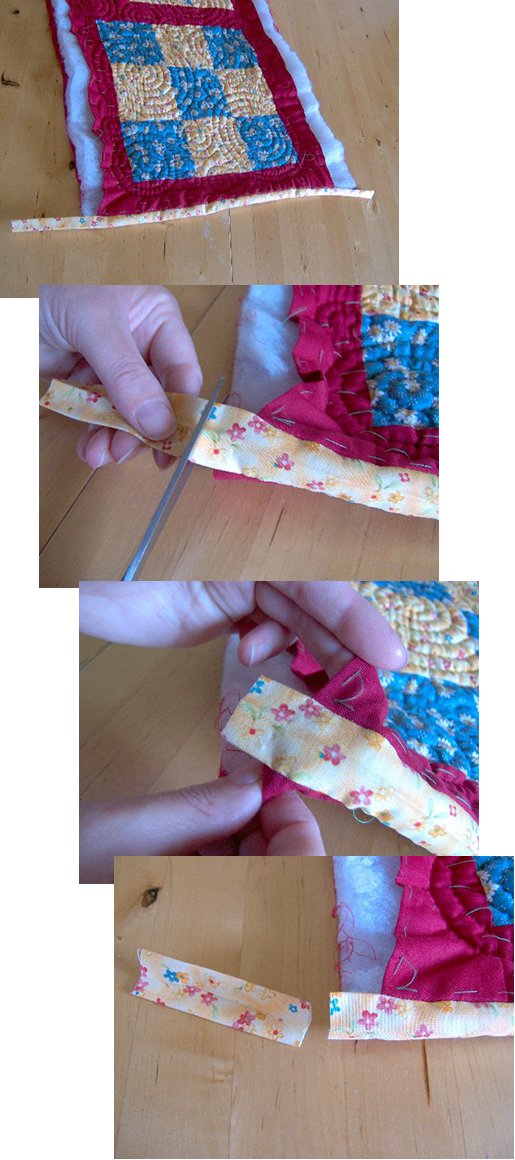
24. Fold in the 1cm ends, wrapping around the end of the quilt. Pin/tack in place.
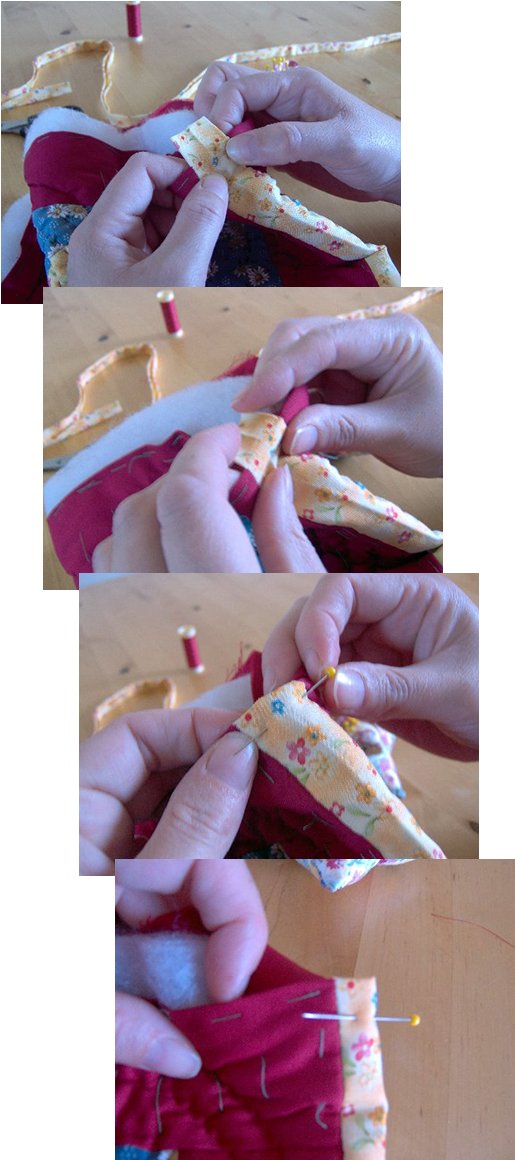
25. Make the binding strips for the remaining two longer lengths of the quilt in the same way as before, remembering to add 4 inches to their length.
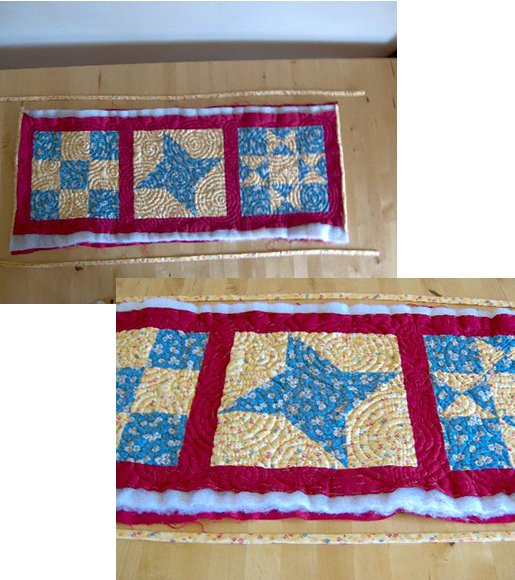
26. Pin and sew one of the long binding strips to the front of the quilt.
The binding should be of equal widths on both sides of the quilted edge and should appear 'full' rather than empty or overstuffed. The backing and wadding (batting) may therefore need a little trimming before the binding is sewn to the back of the quilt (be very careful not to cut off too much, as you need to make sure that when you sew the binding to the back, you are not sewing close to the edge of the backing fabric).
Now trim the excess binding fabric at both ends, leaving 1cm sticking out each end. Fold each 1cm tab under, towards the back of the quilt. Then fold the long length of the binding over the edge of the quilt and pin/tack in place at the back, then sew using slip / blind stitch.

27. Repeat as above for the second long binding strip.
28. Carefully take out the tacking stitches.
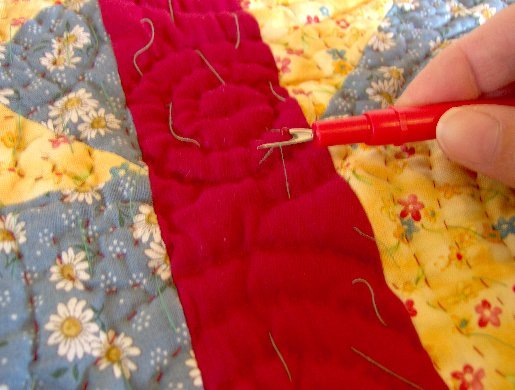
29. Your table runner is now finished, although depending on how heavily your piece is quilted you may wish to add an extra line of quilting a couple of mm from the inside edge of where the border and binding join to help the edges lay flat.
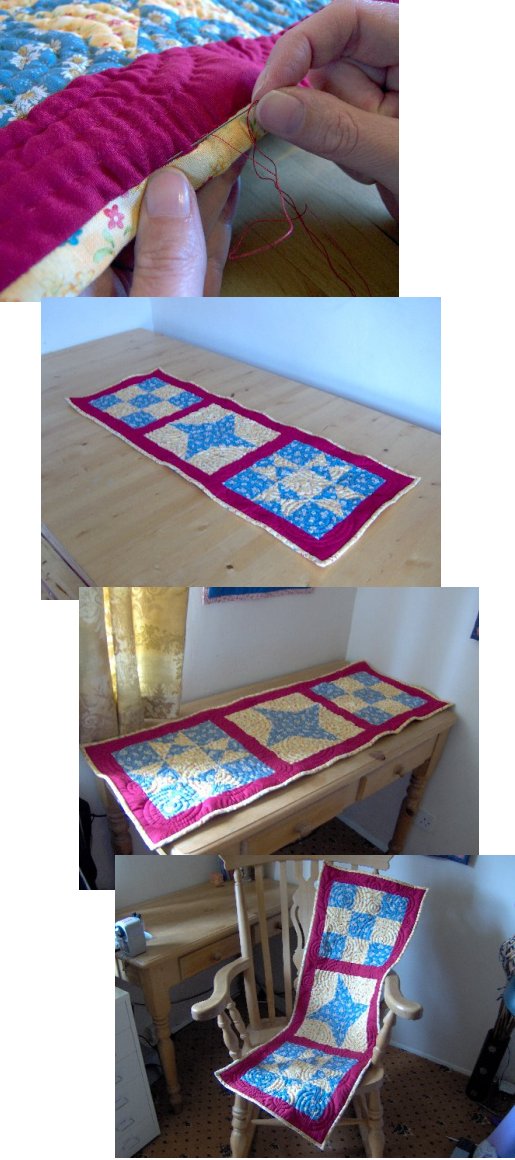
Back to the Patchwork and Quilting menu...


